If a German Shepherd made friends with a wolf and you saw them standing together as though conversing, you would think they were dogs of the same breed.
But that’s only true when you focus on particular physical features like the long muzzle and erect ears. And so you ask, what’s the difference between a German Shepherd and a wolf?
German Shepherds differ from wolves in their body size, eye color, jaw strength, and leg posture. They’re more friendly toward humans, slower in speed, yet more tractable. They also eat a different diet.
It always makes me laugh when I’m out walking my German Shepherd past a young child, and I hear an excited voice, “Mom, look at that wolf!”
This article answers the question of what distinguishes a German Shepherd from a wolf by providing expert information and facts about the wolf and its descendant, the German Shepherd.
Let’s dive in!
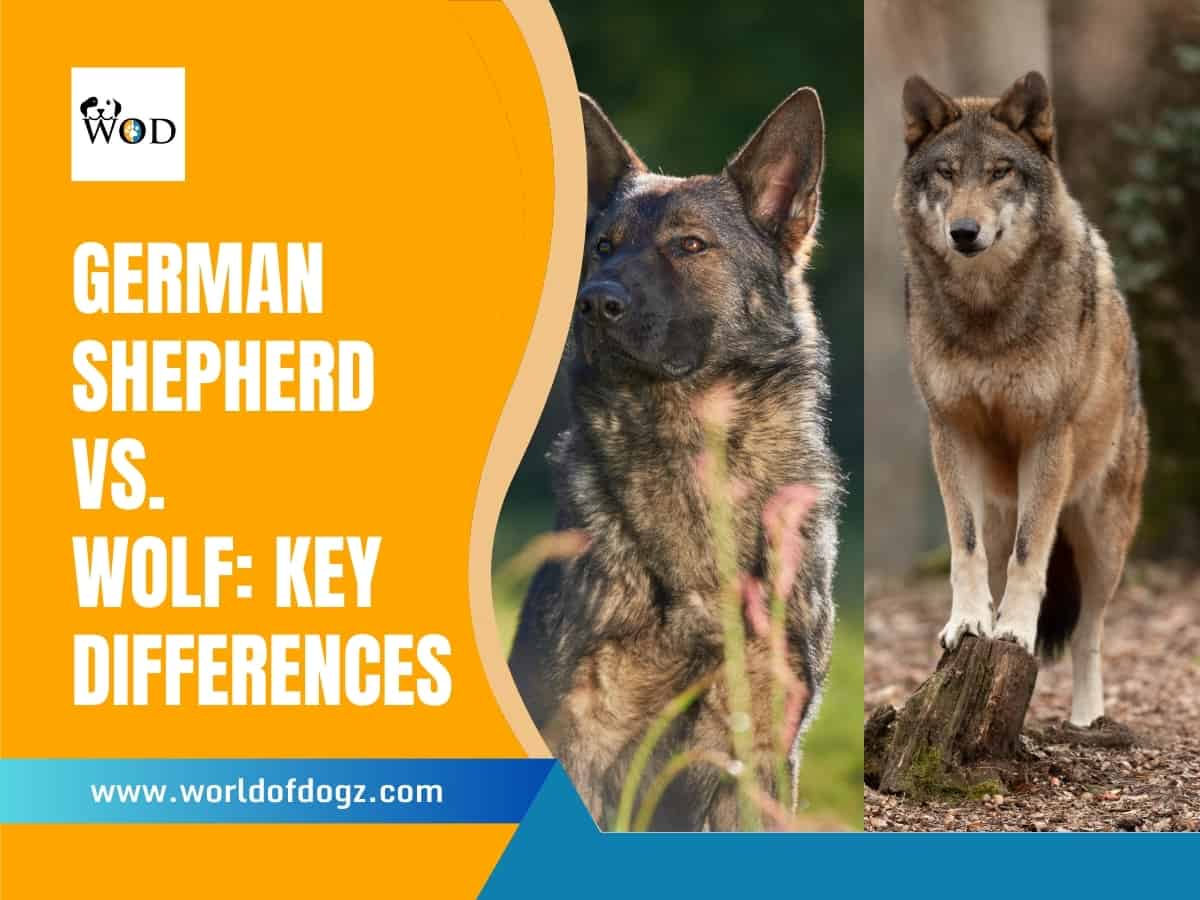
Comparing German Shepherds & Wolves
German Shepherds, wolves, coyotes, and golden jackals belong to the same genus (Canis). That explains their similar physical features: large body size, long legs, short and erect ears, strong skull, muzzle, and dentition.
Read More: Why Do German Shepherds Look Like Wolves?
However, despite their common family species and similar features, they have several differences, including size and physical characteristics, relationships with humans, diet, breeding, speed, tractability, and courage.
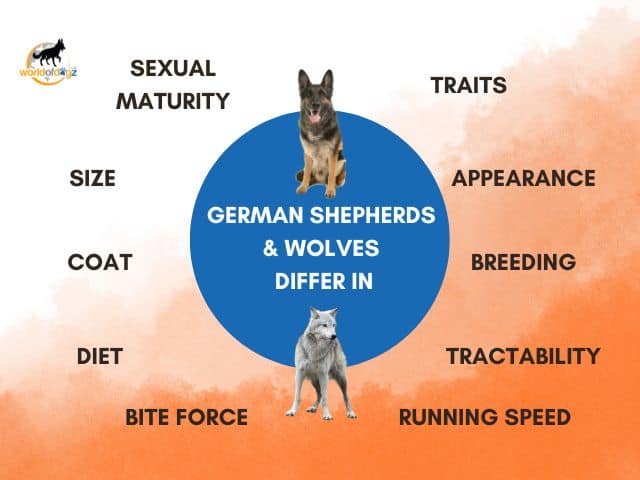
Before we explore these and other German Shepherd vs. wolf differences in some detail, here’s a glance at the facts:
| German Shepherd | Wolf | |
|---|---|---|
| Size | Smaller build (height and weight). | Larger build in height and weight. |
| Appearance | Smaller and narrower wedge-shaped head. Shorter legs. Dark brown almond-shaped eyes. | Larger wedge-shaped head. Longer legs. Amber, pale yellow, or green eyes that glow in the dark. |
| Coat | Various colors, black & tan, black & red, black and silver, sable, white (rare), solid black. | Gray and brown, brown, white, black. |
| Bite Force | 238 PSI (up to 750 in defense) | 400 PSI (up to 1200 in defense) |
| Running Speed | 30 mph (48 km/h) | 43 mph (69 km/h) |
| Traits | Courageous and protective. Will attack a stranger to protect a family member. | More shy and fearful. Won’t usually attack humans. Will run from a hunter. |
| Tractability | Higher tractability level | Lower tractability level |
| Sexual Maturity | 5-9 months | 2 years |
| Breeding | Can have a litter twice per year. Mating can be all year round. Average litter size – 8 | Only one litter annually. Mating is between January to April. Average litter size – 5 |
| Diet | Omnivore | Carnivore |
1. Size Differences
German Shepherds are among the largest breeds of domesticated dogs in the world. However, a GSD doesn’t win the size prize compared to a wolf.
Wolves have a larger build, both in their height and weight. Females tend to be smaller for both species, especially regarding weight.
According to Wolf Haven International, the heaviest male German Shepherd will be about the size of the heaviest female gray wolf.
Similarly, the tallest male German Shepherd is around the average height of a male or female gray wolf, as seen in the tabled details.
| German Shepherd | Wolf (Gray) | ||
| Height | Male | 24ʺ-26ʺ (60–65 cm) | 23ʺ-32ʺ (58–81 cm) |
| Female | 22ʺ-24ʺ (55–60 cm) | 23ʺ-32ʺ (58–81 cm) | |
| Weight | Male | 65-90lbs (30-40kg) | 80-110lbs (36-50kg) |
| Female | 50-70lbs (22-32kg) | 60-80lbs (27-36kg) |
2. Physical Features
Several other physical features define the differences between the German Shepherd and the wolf:
Skull and Jaw
Although the German Shepherd and the wolf have the same teeth (42), the wolf has a stronger and larger skull and jaw.
The stronger skull and jaw favor the wolf’s need to bite and break the bones of its prey in the wild compared to the German Shepherd, which relies on readymade, easy-to-chew food.
Also, the wolf’s bite force is around 400 psi (pounds of pressure per square inch) and can increase up to 1,200 psi when acting in defense.
The German Shepherd’s bite strength ranges around 238 and 400 psi, the range for large domestic dogs. But the German Shepherds’ bite force can rise to 750 psi in defense.
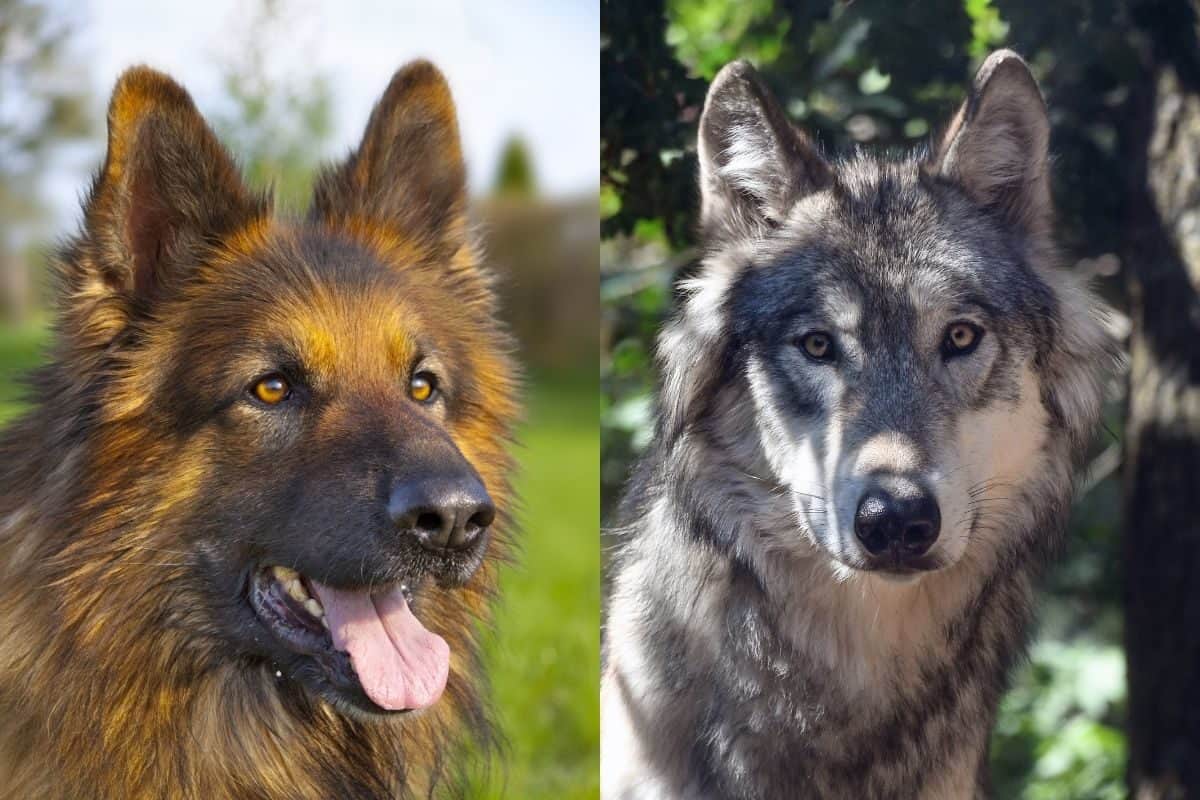
Head and Eyes
A wolf’s head is wedge-shaped and large when seen in light with the rest of the body. While most dogs have smaller and narrower heads, the German Shepherd’s head mimics the wedge shape of a wolf’s head but is narrower.
Both the German Shepherd and the wolf have long muzzles. However, the wolf’s muzzle stands out in its proportional size, equal to that of its skull.
Regarding the eyes, the German Shepherd has dark brown almond-shaped eyes that are diagonally set but without protrusion.
The wolf, instead, can have amber, pale yellow, or green eyes. The eyes have tapetum lucidum, a unique layer of reflective cells behind the retina, which causes the wolf’s eye to glow in the dark.
Shoulder and Back
Compared to the wolf, the German Shepherd has long and diagonally-angled shoulder blades, while the wolf’s shoulders are well-angled and close together. That gives the wolf better mobility compared to the German Shepherd.
The back of a German Shepherd is straight and has a clear downward slope from the shoulders to the tail. The wolf’s back is longer and straight all the way.
Legs and Paws
A wolf’s legs are straight, both at the fore and hind. Instead, the German Shepherd has straight legs at the fore and crouching legs at the rear.
The feet (paws) of the wolf are large, with two of the middle toes on the front legs longer than the rest. This toe formation facilitates the wolf’s springing when in motion.
The differences between the legs and paws of the German Shepherd and the wolf create running speed differences between the two canines.
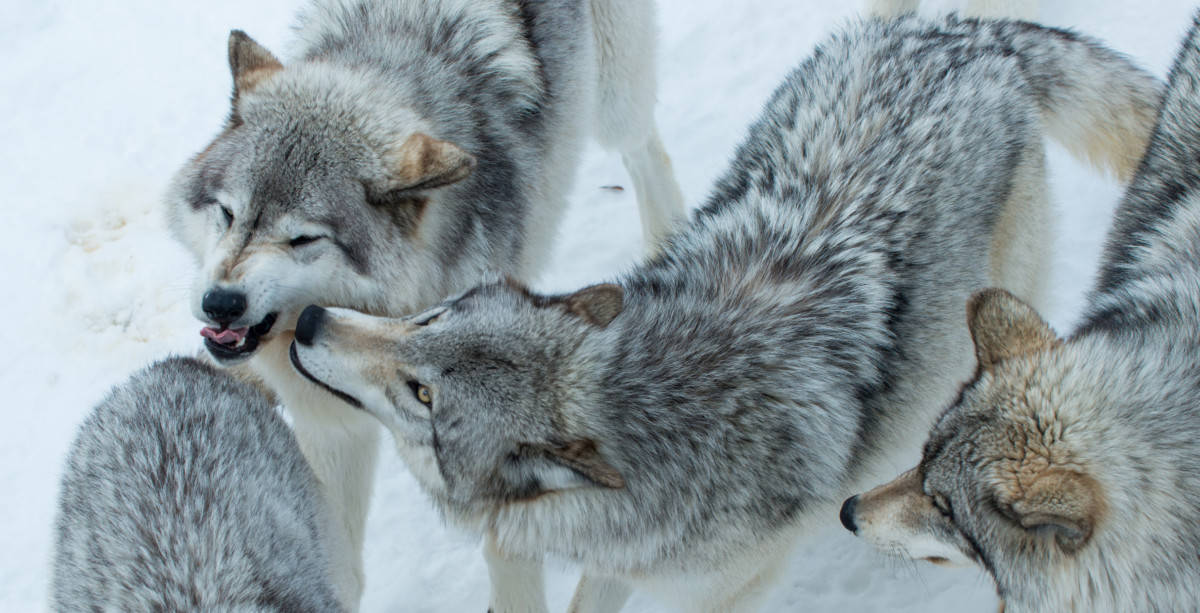
Coat Type and Color
Both the German Shepherd and the wolf have double coats. The German Shepherd has a short or medium-length double coat with harsh, straight hair. Longer hairs may, however, manifest on the neck and the rear of the legs.
The wolf has a coarse outer coat, long guard hair, and a soft undercoat. Hair may appear longer on the cape (the fur from the head and neck) and more inside the ears.
As for coat color, the German Shepherd can adorn various coat colors, including black and tan, sable, solid black, and black and red, among others.
Instead, the gray wolf typically has a gray and brown coat with dull yellow or yellow-brown facial markings. Solid white, brown, and black wolf coat colors are also possible.
3. Running Speed Differences
Because of its straight legs and probably because of its survival skills in the wild, a wolf runs faster than the German Shepherd.
On average, a wolf can run six mph (miles per hour) or ten kmp/h (kilometers per hour). But this speed can increase up to 43 mph (69 km/h) when in a chase.
In contrast, the German Shepherd’s maximum running speed in a chase is 30 mph (48 km/h).
4. Attachment to Humans Contrasts
Thanks to centuries of domestication, German Shepherds, like all dogs, have adapted to a life among humans.
Living among humans has made German Shepherds dependent on humans for their survival. They’re also attached to humans in a friendly and loyal relationship, making them great pets.
Instead, wild, undomesticated wolves have to fend for themselves and have retained their hunting survival skills.
They don’t need humans to feed or protect them from extreme weather or predators like hunting humans, bears, and Siberian tigers.
A study comparing dog and socialized wolves’ interaction with humans found that domestication is responsible for the dog’s need to be close to human companions.
But that’s not the case with wolves, even when they’re kept in captivity or bonded with humans at a wolf center.
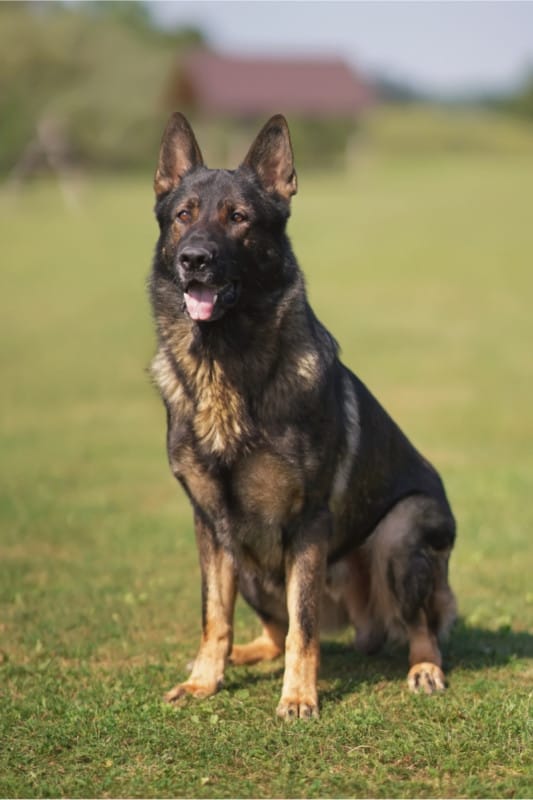

5. Tractability Differences
Dogs are not only trainable but also tractable. That means you can easily control, direct, and handle a German Shepherd and have it obey verbal and gesture commands.
Not so with the wolf!
Although you can train a wolf, its tractability level remains much lower than that of a German Shepherd or any dog.
Recent research with hand-raised wolves and dogs has confirmed that wolves remain less tractable even after intensive socialization, especially when accessing resources.
Dogs, on the other hand, clearly show their tractability, irrespective of differences in their rearing contexts.
6. Differences in Sexual Maturity
German Shepherds, like other dogs, mature quickly. However, while most dogs are sexually mature by five to nine months, German Shepherds may go up to two years.
But that is still faster than a wolf. Wolves don’t reach sexual maturity before age two, but it takes much longer for them to be ready to breed.
In both species, sexual maturity comes with hormonal fluctuations and related changes in behavior, especially a sense of aggression and stubbornness.
Wolves will portray more aggression in puberty because of the complex status roles in their pack. They need to challenge their pack mates for higher role status in the pack, causing them to show more aggression.
The domesticated German Shepherd shows less of this puberty aggression. Besides, aggressive tendencies are nipped in the bud with training when German Shepherds are still puppies.

7. Breeding Differences
While the gestation period of the gray wolf and the German Shepherd is around 63 days, the two canines have different breeding rhythms. German Shepherds can breed twice a year. Wolves only have one litter annually from January to April.
While German Shepherds have an average litter size of 8 puppies and can range from 1-15, wolves have smaller litters, on average, of 5 pups.
Also, wolves rear their pups as a family (with a mother and father) while the German Shepherd mother takes care of them.
8. Courage Differences
One of the key characteristics used to describe German Shepherds is that they’re courageous. That’s why they’re seen in many high-risk situations, such as police operations and rescue missions.
Also, German Shepherds are good guard dogs and will readily attack a stranger to protect a family member.
In comparison, wolves are more shy and fearful and won’t attack humans under normal circumstances. In fact, they’ll run away from a hunter who approaches their prey.
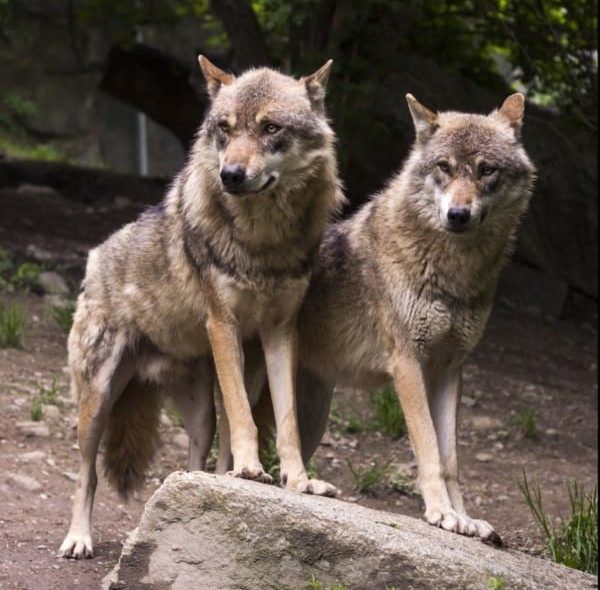
The International Wolf Center suggests that wolves are afraid of humans because of two factors:
- The persistent hounding of wolves by humans over the centuries.
- The fact that humans stand upright is different from other wolf predators.
9. Diet Variations
German Shepherds are omnivores. Because of domestication and the resulting adaptation, these canines, like other dogs, can process various food types.
Wolves are carnivores, mostly relying on raw meat for survival, although they may eat plant food occasionally. Unlike wolves, the German Shepherd’s stomach processes raw meat and food poorly.
Besides, GSDs have lost the ability to ward off raw meat and food pathogens. That’s why the AVMA discourages feeding your dog with raw food, as it comes with the risk of illnesses for both your dog and other family members.
However, they understand that some owners prefer to feed a raw diet to their dogs.
The gray wolf also eats a lot more in a single ‘serving’ than a German Shepherd—around 20 lbs (9kg) of meat in a single meal.
Because their food isn’t readily given to them daily, they eat a lot to last them some time. But wolves can also withstand hunger longer than German Shepherds can.
The preceding comparisons give you a comprehensive idea of how years of domestication have distinguished dogs from their wolf ancestors.
However, if you’ve always considered the German Shepherd among the strongest dog breeds, you may still wonder if they’re stronger than wolves.
10. Differences in Strength
A common question when comparing the wolf to the German Shepherd is, who is the strongest?
The German Shepherd isn’t stronger than the wolf, considering that a wolf has a larger body build in weight and height and a more robust skull and jaw.
When defending itself, a large wolf can bite down with over 1,200 PSI compared to the GSDs’ 238 PSI.
However, in hostile situations, German Shepherds can have the upper hand for two reasons:
- A male German Shepherd with a body weight of 90lbs (40kg) will have an advantage over an attacking 60lbs (26kg) young female wolf.
- When animals fight, the overpowered party often ends the fight by escaping. A German Shepherd may show strength over a wolf due to the dog’s courage over the wolf’s fear and shyness.
That said, a full-grown wolf will have an advantage in strength over a German Shepherd. Wolves have been caught on camera attacking German Shepherds and overpowering them.
Wolves will also be stronger than German Shepherds if they act in packs, as is often the case.
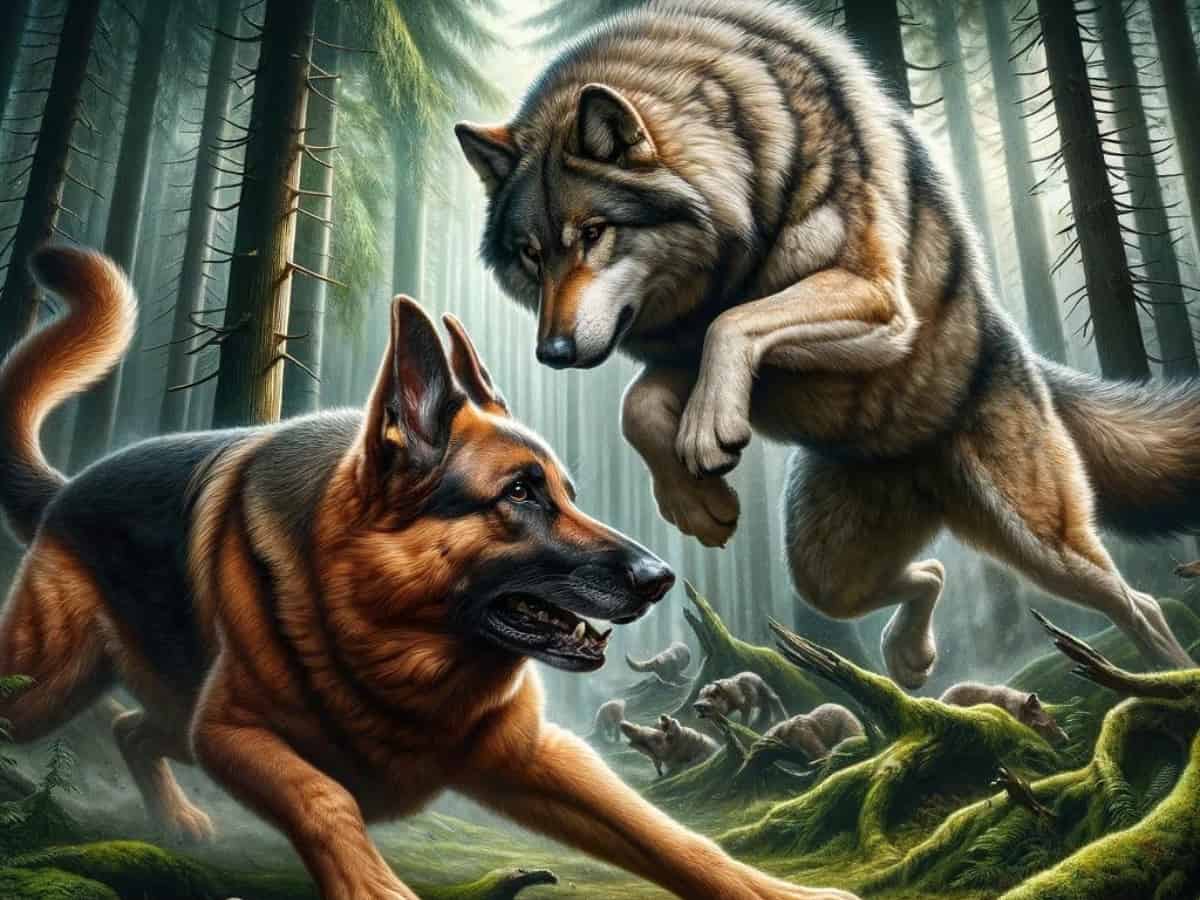
Key Takeaways
People often say that the German Shepherd looks like a wolf. And while that’s true to some extent, the German Shepherd has more differences than similarities with the wolf.
Here are two key takeaways on German Shepherd vs. wolf differences:
- The German Shepherd is more people-friendly than the wolf, thanks to centuries of dog domestication.
- Even though they may look alike at first glance, the German Shepherd, compared to the wolf, has a smaller build, with at least 10-20lbs (4.5-9kg) of weight difference and 6ʺ (15cm) of height difference.





